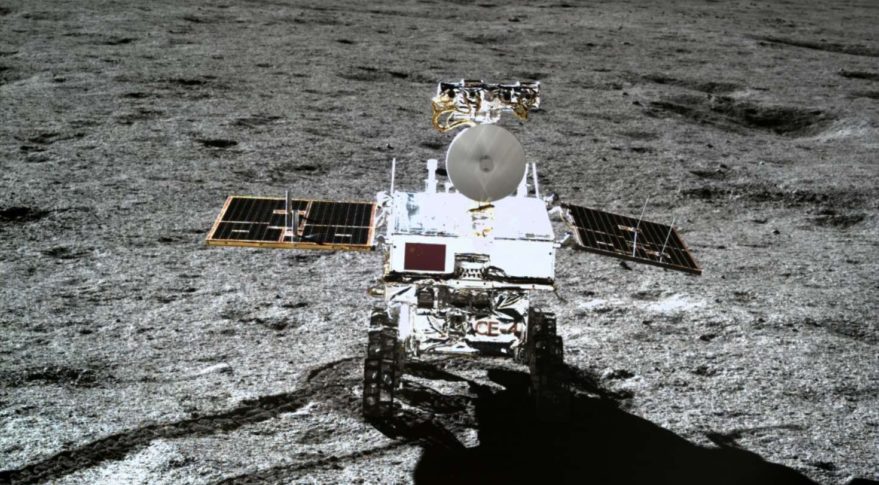Chang'e 4 Spacecraft Enter 3rd Lunar Night, Yutu 2 Hits Design Lifetime

HELSINKI — The Chang'e-4 lander and Yutu-2 have powered down for a third lunar nighttime on the far side of the moon, with the rover reaching its design lifetime.
The 140-kilogram Yutu-2 rover entered a sleep state at 12:16 a.m. Eastern Wednesday, according to the China Lunar Exploration Program (CLEP), having reached a total drive distance of 163 meters across three lunar days in Von Kármán crater.
Yutu-2 has now reached its design lifetime of three months, having been deployed onto the surface of the moon shortly after the Chang'e-4 lunar far side landing on Jan. 2.
Related: Chang'e 4 in Pictures: China on the Moon's Far Side
The first Yutu rover, which set down on Mare Imbrium on the near side of the moon as part of the Chang'e-3 mission launched in December 2013, managed to rove just 114 meters before a short circuit during its second lunar day left it unable to move. The rover continued to function while stationary until mid-2016.
With all systems and payloads operating well, the Yutu-2 team will continue roving and science data collection on lunar day 4 of the Chang'e-4 mission, according to a CLEP announcement (link in Chinese).
Yutu-2 added 43 meters to its overall drive distance in its third day of activities, continuing a path to the northwest of the landing site, which was recently named 'Statio Tianhe' by the International Astronomical Union.
Get the Space.com Newsletter
Breaking space news, the latest updates on rocket launches, skywatching events and more!
The rover just covered seven meters between waking for lunar day 3 on Feb. 28 and Mar. 3, during which time it navigated carefully toward a 20 centimeter diameter rock in order to analyze the specimen with an infrared and visible light spectrometer to determine its origin.
Yutu-2 then powered down between Mar. 3 and Mar. 10 as a precaution against potential issues related to high direct solar radiation, such as overheating, with the sun high in the sky over the landing site in the 115-mile-wide (186 kilometers) Von Kármán crater within the South Pole-Aitken Basin.
The Chang'e-4 lander likewise entered dormant status a few minutes ahead of the rover. Both spacecraft are expected to resume activities sometime after sunrise over the landing site late Mar. 28.
During the first lunar night the lander returned data indicating the temperature had plummeted to minus 190 Celsius (minus 310 Fahrenheit). Both spacecraft close solar arrays and are protected by radioisotope heater units.
Relay satellite activity
As the far side of the moon never faces the Earth, communication and data transmission between ground stations and the Chang'e-4 spacecraft has been facilitated by a relay satellite stationed in a halo orbit around the second Earth-moon Lagrange point.
The Queqiao ('Magpie bridge') satellite earlier this month turned on a low frequency astronomy payload, the Netherlands-China Low-Frequency Explorer, for the first time. NCLE will gradually deploy its three five-meter-long antennae to make observations of the solar system and, potentially, signals from the cosmic 'dark ages'.
A laser ranging test involving an observatory in the southern Chinese province of Yunnan is expected to be carried out in March, targeting a laser retroreflector aboard the Queqiao satellite.
This story was provided by SpaceNews, dedicated to covering all aspects of the space industry.
Join our Space Forums to keep talking space on the latest missions, night sky and more! And if you have a news tip, correction or comment, let us know at: community@space.com.

Andrew is a freelance space journalist with a focus on reporting on China's rapidly growing space sector. He began writing for Space.com in 2019 and writes for SpaceNews, IEEE Spectrum, National Geographic, Sky & Telescope, New Scientist and others. Andrew first caught the space bug when, as a youngster, he saw Voyager images of other worlds in our solar system for the first time. Away from space, Andrew enjoys trail running in the forests of Finland. You can follow him on Twitter @AJ_FI.










